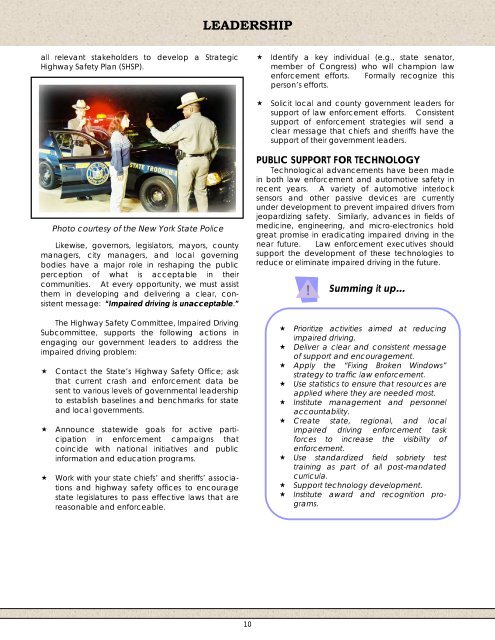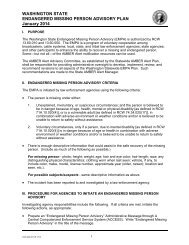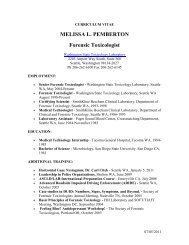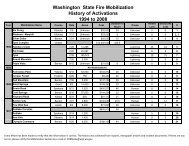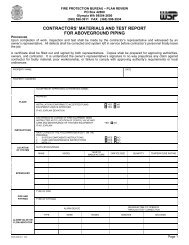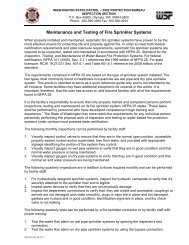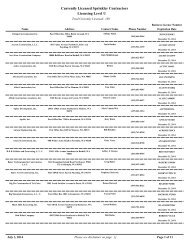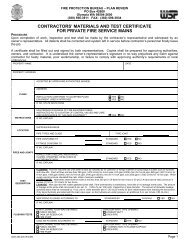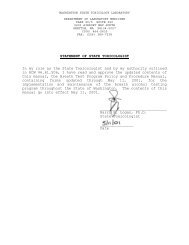LEADERSHIP Encourage the FBI National Academy lawenforcement leadership program to includetraffic law enforcement management in itscurriculum. Support technology development. The mostcurrent technology and development of newtechnology can further reduce impaired drivingand assist in detecting those who do driveimpaired. Institute awards and recognition.⎯⎯⎯⎯IACP Law Enforcement ChallengeState-Level AwardsAgency-Level Awardswww.madd.org/madd_programs/10287contains information on law enforcementrecognition programs.Each year, alcohol-related crashes in theUnited States cost about $51 billion.Source: Blincoe 2002Awards and RecognitionRecognition for a job well done is fundamentalto achieving positive reinforcement and promotionof agency goals and objectives. This is especiallytrue in law enforcement disciplines such as trafficsafety, where tasks are repetitive and sometimestedious, and the connection between the enforcementaction (ticket or summons) and the outcome(lives saved) may not be readily apparent. Lawenforcement executives are usually quick to praisethe officer who apprehends a fleeing suspect in anassault or homicide, but often neglect to providesuch praise to the officers who routinely prevent theperpetration of such crimes in an automobile.Officers who actively enforce impaired driving lawsare preventing assaults and homicides and deservepraise and recognition for their efforts. This type ofrecognition promotes similar behavior among otherofficers.In addition to internal recognition, a variety ofhighway safety organizations provide recognition foroutstanding impaired driving enforcement efforts byindividual officers and their agencies. These awardsprograms enhance self-esteem with the departmentand are invaluable to promoting community relationsand public support for the department.National-Level AwardsThe International Association of Chiefs of Police(IACP) Law Enforcement Challenge is a competitionamong similar sizes and types of law enforcementagencies. It recognizes and rewards the best overalltraffic safety programs in the United States. Theareas of concentration include efforts to enforcelaws and educate the public about occupantprotection, impaired driving, and speeding.Agencies submit an application that documentstheir efforts and effectiveness in these areas. Thewinning safety programs are those that combineofficer training, public information, and enforcementto reduce crashes and injuries within its jurisdiction.Further information can be found online atwww.theiacp.org/awards/NLEC.State-Level AwardsLaw enforcement officials seeking recognition fortheir departments or officers should investigate theavailable state-level awards programs in which theycan participate. A variety of awards are presentedto agencies and individuals at the state level. Theseawards vary greatly from state to state as toeligibility, application, and host agencies, but lawenforcement executives and their impaired drivingenforcement programs can benefit greatly byparticipating in these awards programs. In manystates, the programs are a state version of the IACPLaw Enforcement Challenge.Agency-Level AwardsLaw enforcement leaders should recognize theefforts of their officers who contribute significantly toreducing impaired driving through both internalrecognition and by submitting those officers to localservice clubs and their state MADD executivedirector for possible recognition.GOVERNMENT LEADERSHIPIt is difficult, if not impossible, to accomplishsubstantial improvements in reducing incidents ofimpaired driving and related crashes without strongsupport of our government leaders. Successfulstrategies targeting impaired driving must havesupport from all levels of government. National,state, county, municipal, and Tribal leaders must belobbied for legislative, financial, and moral support.At the federal level, the Secretary ofTransportation and Attorney General’s Office haveidentified impaired driving as a core enforcementpriority. In 2005, Congress passed the landmark Safe,Accountable, Flexible, Efficient Transportation EquityAct: A Legacy for Users (SAFETEA-LU), signed into lawby President Bush on August 10, 2005. SAFETEA-LUprovides unprecedented funding for traffic safetyinitiatives that focus on driver behavior. SAFETEA-LUalso provides an impetus for multi-disciplinarycooperation by requiring the states to bring together9
LEADERSHIPall relevant stakeholders to develop a StrategicHighway Safety Plan (SHSP). Identify a key individual (e.g., state senator,member of Congress) who will champion lawenforcement efforts. Formally recognize thisperson’s efforts. Solicit local and county government leaders forsupport of law enforcement efforts. Consistentsupport of enforcement strategies will send aclear message that chiefs and sheriffs have thesupport of their government leaders.Photo courtesy of the New York State PoliceLikewise, governors, legislators, mayors, countymanagers, city managers, and local governingbodies have a major role in reshaping the publicperception of what is acceptable in theircommunities. At every opportunity, we must assistthem in developing and delivering a clear, consistentmessage: “<strong>Impaired</strong> driving is unacceptable.”The Highway Safety Committee, <strong>Impaired</strong> <strong>Driving</strong><strong>Subcommittee</strong>, supports the following actions inengaging our government leaders to address theimpaired driving problem: Contact the State’s Highway Safety Office; askthat current crash and enforcement data besent to various levels of governmental leadershipto establish baselines and benchmarks for stateand local governments. Announce statewide goals for active participationin enforcement campaigns thatcoincide with national initiatives and publicinformation and education programs. Work with your state chiefs’ and sheriffs’ associationsand highway safety offices to encouragestate legislatures to pass effective laws that arereasonable and enforceable.PUBLIC SUPPORT FOR TECHNOLOGYTechnological advancements have been madein both law enforcement and automotive safety inrecent years. A variety of automotive interlocksensors and other passive devices are currentlyunder development to prevent impaired drivers fromjeopardizing safety. Similarly, advances in fields ofmedicine, engineering, and micro-electronics holdgreat promise in eradicating impaired driving in thenear future. Law enforcement executives shouldsupport the development of these technologies toreduce or eliminate impaired driving in the future.Summing it up… Prioritize activities aimed at reducingimpaired driving. Deliver a clear and consistent messageof support and encouragement. Apply the “Fixing Broken Windows”strategy to traffic law enforcement. Use statistics to ensure that resources areapplied where they are needed most. Institute management and personnelaccountability. Create state, regional, and localimpaired driving enforcement taskforces to increase the visibility ofenforcement. Use standardized field sobriety testtraining as part of all post-mandatedcurricula. Support technology development. Institute award and recognition programs.10


